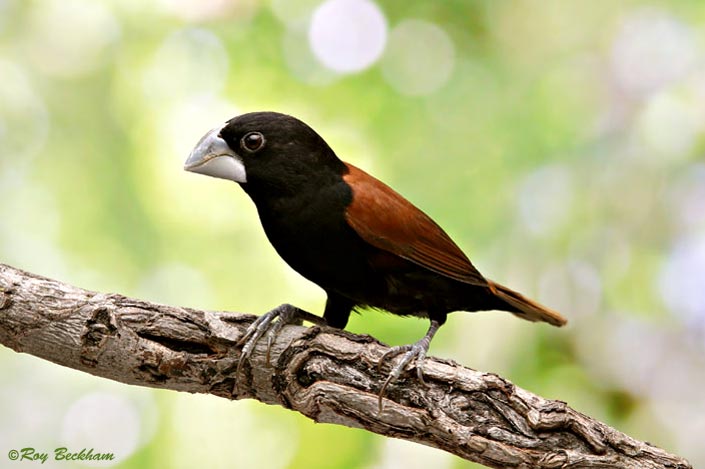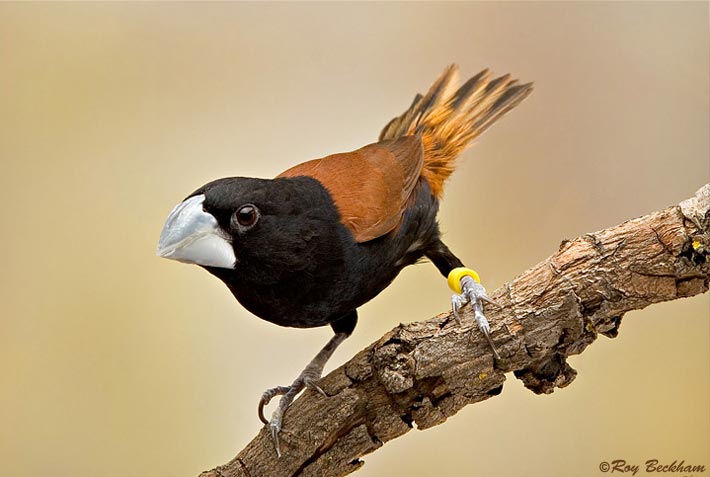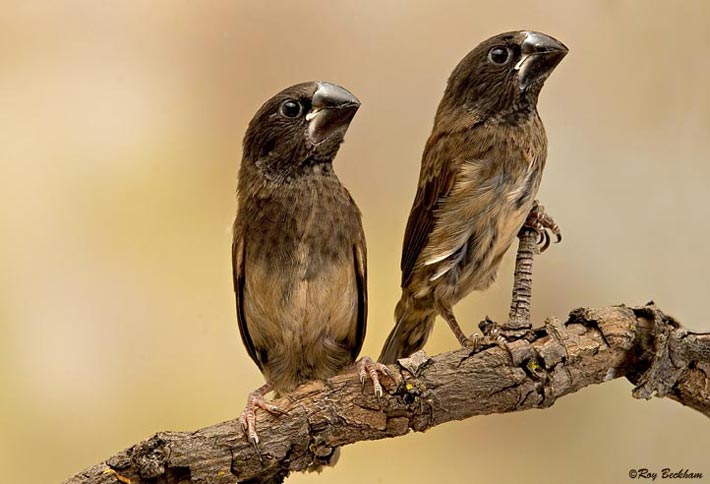|
Common Names
Great Mannikin or Munia, Great-Billed Mannikin or Munia.
Description
The Grand Mannikin can be sexed by the size of the beak, but usually only in a group and then you are picking the extremes. The males will have the largest beak and the hens a more slender beak. However, you'll get a bunch towards the center that just look too similar to sex by this method. I will often band birds in a group with large plastic bands of different colors (see above). When I notice a male singing, I note the color of the band. I then watch carefully to see if those that are not singing are bonding to ones that are singing and try to isolate them as a pair. To be certain of the hen, I will often DNA sex the bird with a blood sample. This way I can save some time by not setting up two males, a dominant one that sings and one that does not.
When a male is singing, do not confuse a bird that seems to get right next to him and place his beak really close to the singing male's beak. This is quite often another male that is performing this peering behavior, but it is not aggressive behavior.
Diet
Like most mannikins or munias, Grand Mannikins prefer the large white prosso millet. I usually feed them this single seed. This seed is also the only millet found in a standard parakeet mix which can also be fed. They will also eagerly eat my eggfood (Roy's eggfood), some greens and soaked seeds, especially Paddy Rice which is offered dry or soaked and sprouted. They will eat this paddy rice even over the millet at times, so I try not to offer them too much. Grit and calcium in the form of crushed egg shell and oyster shell as well as cuttlebone should always be available to them.
 Imported Grand Mannikin. Imported Grand Mannikin.
Breeder's Notes
As always with monomorphic pairs, the first step in breeding is to acquire a true pair. As I mentioned above, I will often DNA sex the birds to make my observations of pairing a bit easier. Many munia that are peaceful in a group will form a dominant pair. This pair seems to stake out the breeding territory and somehow suppresses the breeding of other pairs. Not aggressively, but this is somehow communicated to the other birds. In a very large flight or a planted one with many nesting sites perhaps more than one pair would form, but I do not have such facilities. I would set one pair up in a mixed flight or in a 24" breeding cage. I offered a 5"-6" square nest box with a half open front. The pair in the mixed flight picked a budgie sized box with large round opening that they built a large domed nest in. Typical of Asian munia, the nest was a nice woven ball and the only material used was coconut fiber or other long strands of grass. No soft materials or feathers are used in the lining. I believe that in the humid areas these birds come from, a lining would only make the nest hotter and decrease air circulation.
If all goes well after the nest building, a clutch of 4-5 eggs will be laid and incubation begins after the third egg. Incubation is shared by both sexes, but mostly by the hen. They are quick to leave the nest if you approach and I would rarely find them on the nest when servicing the cages. Chicks begin to hatch after 14 days and can take a bit longer than most to fledge. Fledging usually takes a full 21-24 days. I have been trying to increase the protein of the diet of the breeding birds to try and accelerate their growth rate as some parents seem impatient with the young's progress. I have had them pluck the backs of the birds as they reach the feathering stage. I believe a sign that the parents want the birds out. Once fledged, the birds take another couple of weeks to wean, but it is best to leave them for at least 3 weeks. There is no problem with leaving the birds with the parents for a longer period, but the parents may not go back to nest if the area is getting a little crowded.
The Grand mannikin can be fostered under Society finches fairly well. I have also used other mannikins such as the Gray Crown mannikin or even a strange foster pair of a Society x Zebra. The trick is to have vigorous feeders that do not seem to mind the longer period the chicks are in the nest. It is also best not to mix the chicks with other birds that might have a faster growth rate.
Additional Notes
The beak is a powerful beak. It is not just for show. It can inflict a painful little pinch if they get you in a sensitive spot. Moreover, because it is so powerful, you will not want to use a split aluminum band on these birds. They can crush them down and end up causing circulation and infection problems in their feet. Closed aluminum bands placed on chicks in the nest seem to be fine through the life of the bird. I used a 2.8mm band or an "E" size band for them.
At first glance these birds appear to be Black Headed Munia with large beaks, but the coloration is different. The black head mask of the Black Headed Munia only extends to the breast, whereas the Grand Mannikin is completely black on the underside. There is of course a great difference in the size of the beak and overall body.
There are four subspecies of Grand Mannikins. They vary slightly in size and tail color and come from distinct areas of New Guinea. Based on paintings in Robin Restall's "Munias and Mannikins", 1997, I believe that the subspecies I have and are pictured here are of the nominate subspecies (L. g. grandis).
|












